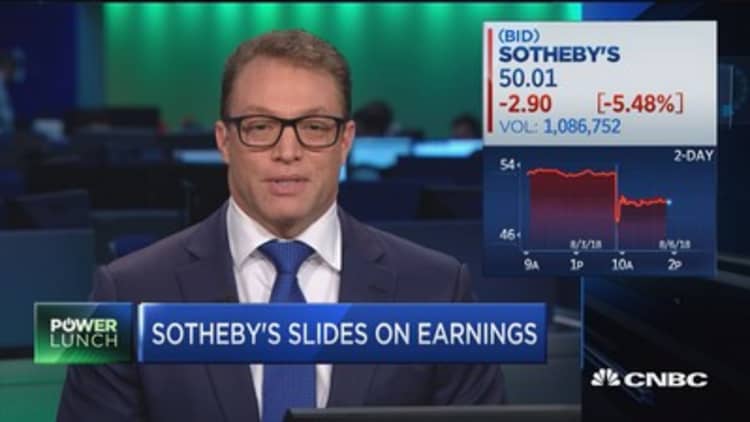
The art market is not always what it seems.
Sotheby's stock price is under pressure — shedding more than 5 percent in trading Monday — after the company's earnings showed a decline in margins. Much of the margin decline was due to two paintings that appeared to sell for massive prices, but actually lost or made very little money for the auction house. Sotheby's won't say which paintings caused the hit, but art industry sources say the first was an Amedeo Modigliani that sold in New York for $157.2 million and the other was a Pablo Picasso that sold in London for $36 million.
To most observers, the sale of paintings for $157 million and $36 million would be huge wins for Sotheby's. But in the current hyper-competitive world of art consignments, where the auction houses pay sellers handsomely to secure top work for auction, the sale prices can often bear little relationship to the actual profits made by the auction houses.
Both paintings mentioned in the earnings call were guaranteed by Sotheby's, meaning Sotheby's agreed to pay the sellers a fixed price regardless of the eventual sale price. In the case of the Modigliani, which sold in the May sale, the painting was likely guaranteed by Sotheby's for around $150 million. Sotheby's then went out and found a buyer willing to make an irrevocable bid for a slightly lower amount. When the painting came under the auction block, it sold with a hammer price of $139 million. It's unclear who the buyer was but it was likely sold to the irrevocable bidder. The buyer's premium, or fee paid by the buyer, more than made up the loss — but only slightly.
On the earnings call Monday morning, Sotheby's CEO Tad Smith declined to name the paintings. But he said that with one of them "the contribution was positive, and if we had had more bidding it would have been robustly attractive" to the company. The second painting, he said, "was a pricing error."
Art industry sources say the second painting was Picasso's 1932 work "Buste de Femme de Profil (Femme Ecrivant)." The work was estimated to sell for $45 million, and Sotheby's guaranteed the seller a price of around that amount. Sotheby's then had an irrevocable bid for $36 million, and it sold to the irrevocable bidder for $36 million. Even with the buyer's commission, Sotheby's ended losing between $6 million to $7 million on the painting, according to art market experts.
When he took over the company in 2015, Smith said that he would be disciplined when it came to guarantees. He said he would be "focused on returns on invested capital and being careful with shareholders' money."
Two paintings don't make a trend. And Sotheby's stock may well come back — especially since the overall art market remains strong and the important fall sales are shaping up to be solid.
But the tales of the Picasso and the Modigliani show that pricing and selling masterpieces is more an art than a science.


